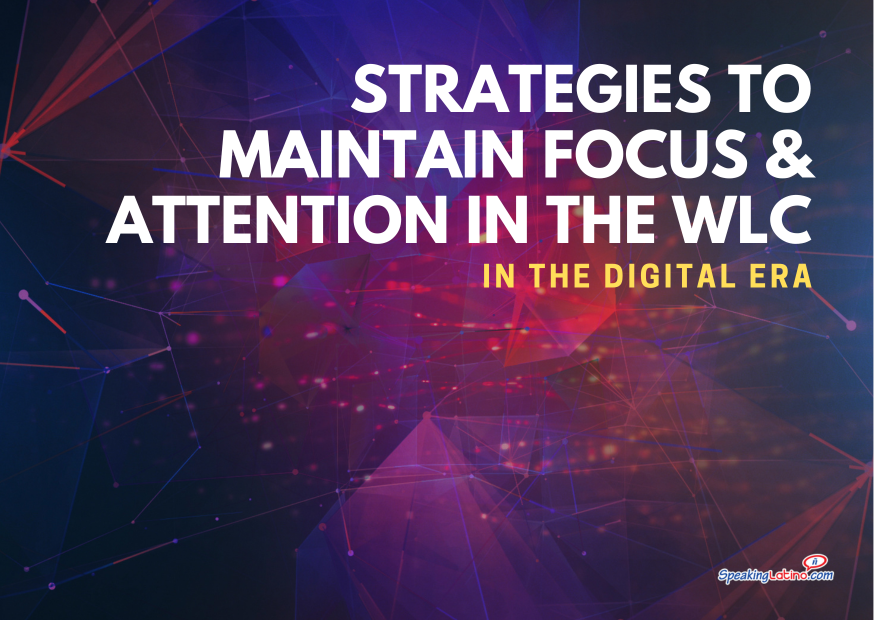
The content of this article is based on the presentation, Attention in the Digital Age by Fanest Coronado, which was part of the World Language Teacher Summit.
The Battle for Focus in Modern Classrooms
In the digital era, the infusion of technology into our daily lives has reshaped the way we engage with the world—including how we learn languages. The digital landscape, brimming with constant notifications and a wealth of information at our fingertips, poses significant challenges for students and educators alike. Maintaining focus and attention in language classrooms has become a hurdle that requires innovative educational approaches and strategies to overcome.
The Neuroscience of Attention in Bilingualism
The cultivation of attention is notably crucial when it comes to language learning. Research reveals that bilingual individuals enhance their attentional control through the habitual practice of language switching. This act of alternating between languages triggers the development of particular brain regions associated with attention. It’s not merely the knowledge of multiple languages that provides cognitive advantages, but the attention-demanding process of juggling them that sharpens the mind. Understanding this neural interplay sets the stage for why attention training should be a cornerstone of language education.
Multitasking: Debunking the Myth
The misconception of multitasking stands as a stark challenge in the commitment to focus. The myth purports that one can effectively handle several tasks simultaneously. However, cognitive science confirms that what is often perceived as multitasking is primarily task-switching, where the level of attention to each task is diluted. Amidst the influx of digital distractions, debunking this myth becomes foundational in fostering an environment conducive to deep concentration and language comprehension.
Exercise and Mindfulness as Ancillary Aids in Language Acquisition
To combat fragmented attention spans and promote concentration, physical exercise and mindfulness practices emerge as vital supplementary activities in language pedagogy. These practices are not mere distractions from core language learning but serve to heighten neurological functions tied to attention and focus. The incorporation of short meditation sessions or concentration-building exercises into language classes supports not only mental well-being but also primes the brain for the rigors of language acquisition.
Strategies for Digital Distraction Management
As digital devices increasingly permeate the classroom, establishing effective management strategies is imperative. Setting clear guidelines around device usage and employing classroom management techniques can help students navigate the snares of potential digital pitfalls. Addressing and scheduling distractions strategically, for instance with the Pomodoro technique which advocates for intervals of focused work followed by short breaks, reaffirms the balance between intensive learning and necessary respite.
Interactive Learning Tools: Friend or Foe?
In the modern classroom, interactive learning tools are double-edged swords. While they have the potential to transform language learning through collaboration, creativity, and critical thinking, they also run the risk of contributing to the overstimulation problem. The key lies in their judicious use; setting time limits and clear objectives can ensure these tools serve as assets, not adversities, in maintaining student focus.

Setting time limits and clear objectives can ensure digital tools serve as assets, not adversities, in maintaining student focus
Flipping the Classroom to Counteract Overstimulation
The 'flipped classroom' approach adapts to the changing attentional landscape by providing content for students to engage with before the class, thus allowing classroom time to be dedicated to interactive activities. This method acknowledges and constructs upon the limited attention spans wrought by digital overstimulation, directing classroom energy towards application and exploration rather than passive reception.
Leveraging Deep Work and Cognitive Training
Understanding the nature of 'deep work'—periods of profound focus where the brain synthesizes complex information—has substantial implications for language learning. Intense concentration fosters the production of myelin, which improves neuronal communication and accelerates information transmission. Teaching students how to engage in deep work, such as through uninterrupted study cycles, empowers them to access the benefits of this heightened state of cognition.
FAQs About Attention in the Digital Age
How does constant digital stimulation affect students' ability to focus in the language classroom?
Constant digital stimulation can have a significant impact on students' ability to focus in the language classroom. The influx of information, notifications, and stimuli from digital devices can lead to distractions, making it challenging for students to concentrate and engage effectively in language learning. Students may struggle with maintaining sustained attention due to the constant presence of digital devices and the allure of social media platforms.
To address this challenge, educators can implement strategies to manage digital distractions and promote focused attention during language tasks. Techniques such as mindfulness exercises, concentration-building activities, and the Pomodoro technique can help students develop attention skills and improve their ability to concentrate. By emphasizing the importance of focused attention and discouraging multitasking, teachers can create a more engaging and productive learning environment.
Furthermore, utilizing interactive learning tools that enhance language learning while encouraging collaboration, creativity, and critical thinking can help strike a balance between engagement with digital tools and avoiding overstimulation . Setting time limits for activities and providing clear guidelines on device usage can also help students maintain focus and minimize distractions in the classroom.
In conclusion, understanding the impact of constant digital stimulation on students' attention is crucial for language educators. By implementing effective strategies to manage distractions and promote focused attention, teachers can create a conducive learning environment that enhances language learning outcomes.
What are some effective strategies for managing distractions and promoting engagement in language learning?
Effective strategies for managing distractions and promoting engagement in language learning include:
- Establishing clear guidelines: Set clear expectations for device usage in the classroom and provide specific instructions on when and how devices should be used.
- Encouraging active participation: Design activities that require active engagement and participation to keep students focused on the task at hand.
- Implementing mindfulness exercises: Integrate mindfulness and focus techniques into language lessons to help students develop sustained attention.
- Using interactive learning tools: Utilize digital tools that enhance language learning, encourage collaboration, creativity, and critical thinking while setting time limits to maintain focus.
- Incorporating concentration-building activities: Introduce activities such as the Pomodoro technique to help students improve their attention skills and focus on specific tasks.
- Providing face-to-face interaction: Implement approaches like the flipped classroom model, which allows for face-to-face interaction and language activities to enhance engagement.
- Balancing technology use: Strike a balance between engagement with digital tools and avoiding overstimulation by using technology strategically to enhance learning outcomes.
- Discouraging multitasking: Emphasize the importance of focused attention during language tasks and discourage multitasking to promote deep concentration and comprehension.
- Guiding students in device usage: Offer guidance on safe and effective use of digital devices to help students improve their mental processes while using technology.
- Promoting deep work: Encourage students to engage in deep work, focusing intensely on language tasks to enhance learning outcomes and concentration.
By implementing these strategies, language educators can effectively manage distractions, promote engagement, and create a conducive learning environment that supports students' language learning journey.

Teaching students how to engage in deep work, such as through uninterrupted study cycles, empowers them to access the benefits of this heightened state of cognition.
What insights does neuroscience provide about attention in the digital age and its impact on language education?
Neuroscience offers valuable insights into attention in the digital age and its impact on language education. Here are some key insights:
- Attention is a critical cognitive process: Neuroscience research highlights the importance of attention as a fundamental cognitive process that plays a crucial role in learning and memory.
- Digital distractions can hinder deep concentration: Constant digital stimulation and distractions from smartphones, social media, and other digital platforms can impede students' ability to maintain deep concentration and comprehension in the language classroom.
- Mindfulness and focus techniques can enhance attention skills: Integrating mindfulness exercises and concentration-building activities into language lessons can help students develop attention skills and improve their ability to focus on language tasks.
- Multitasking can impact comprehension: Neuroscience suggests that multitasking can hinder deep concentration and comprehension, emphasizing the importance of promoting focused attention during language tasks.
- Balancing engagement with digital tools is crucial: Neuroscience underscores the importance of balancing engagement with interactive learning tools to avoid overstimulation and promote effective language learning outcomes.
- Attention is the gateway to the learning process: Neuroscience supports the idea that attention serves as the door to the learning process, highlighting its significance in initiating and sustaining the language learning journey.
By leveraging insights from neuroscience, language educators can better understand the impact of attention in the digital age on language education and implement strategies to enhance students' attention skills, promote engagement, and optimize learning outcomes in the language classroom.
The Way Forward
The phenomenon of divided attention in the digital age necessitates a reevaluation of language teaching methodologies. As we grapple with the attentional demands times have placed upon us, there is a growing need for implementing strategies that acknowledge and address these challenges.
Engaging with focused periods of learning, applying classroom management techniques, and incorporating mindfulness and physical exercise into routines, we can pave the way for more effective learning experiences. Literature such as "Deep Work: Rules for Focused Success in a Distracted World," "Teaching Young Learners to Think," and "The Polyglot Project" can provide further insights into these strategies, extending the discussion on how best to adapt our educational approaches in the attention-scarce landscape of the digital age.
For further information and guidance on unlocking one's language-learning potential in this challenging new era, educational specialists remain accessible through social media platforms, ready to aid students and fellow educators in mastering the art of attention in the digital age.